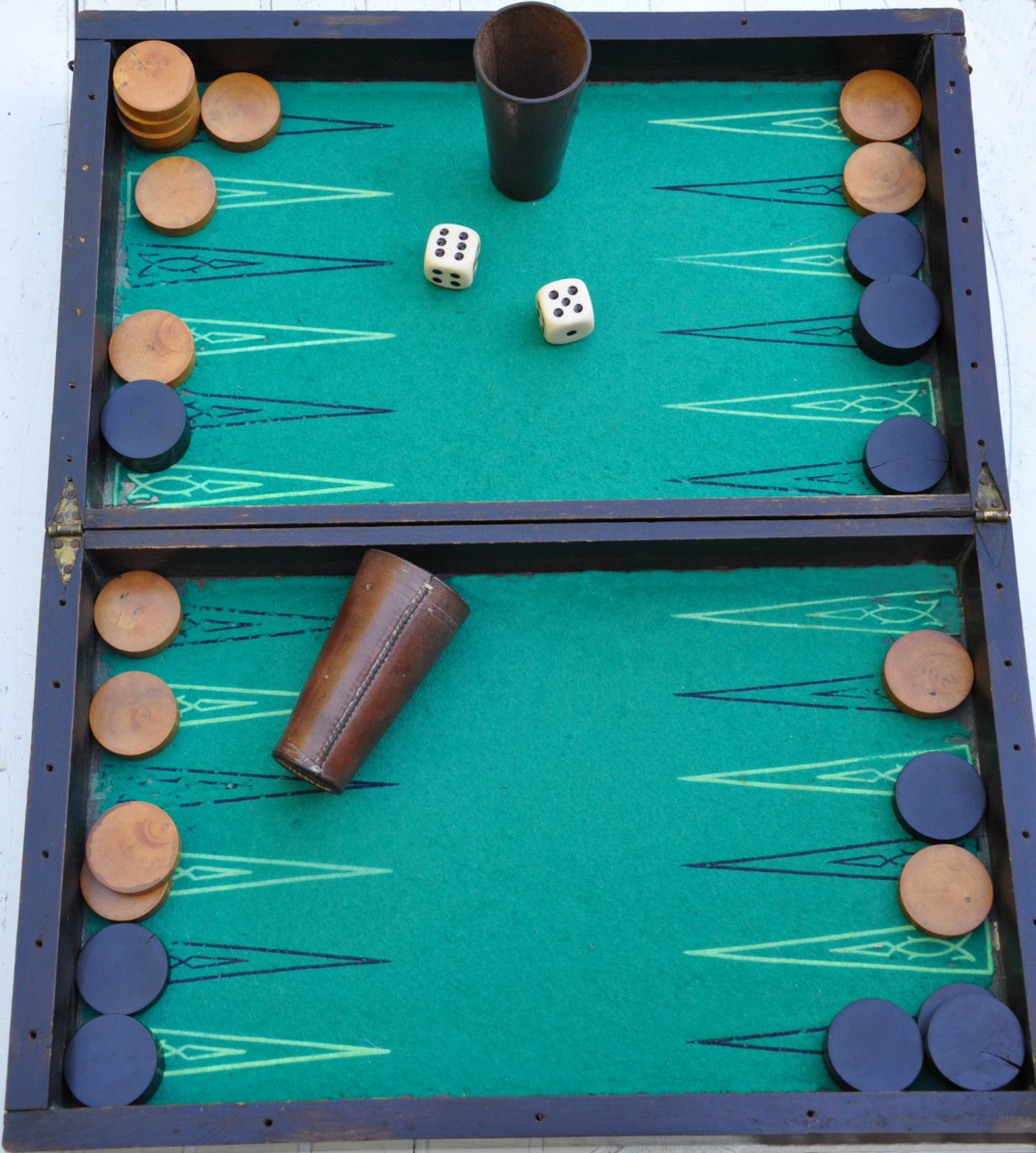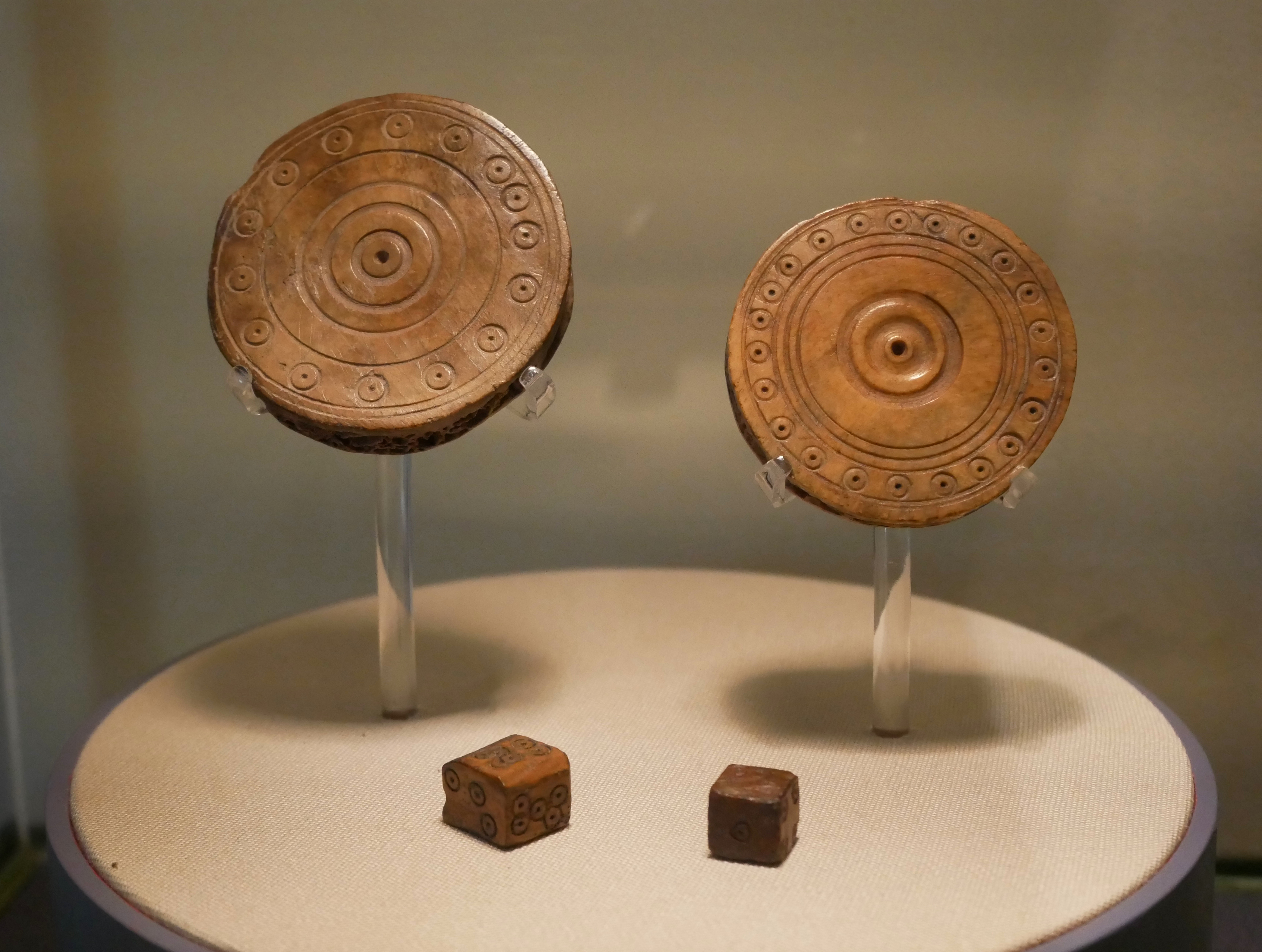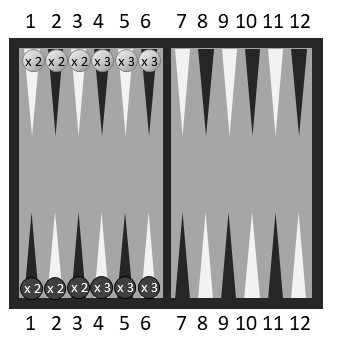|
Févga
Fevga is a popular Greek tables game for two players. It is usually played as one of three different games in succession – the others being Portes and Plakoto – in social gatherings or coffee shops. When played in this way, it is known as Tavli. Very similar games, with slight variations, are Turkish Moultezim, Russian Narde and Egyptian and Lebanese Tawla 31.Mamoun (2018), p. 1 Overview Fevga is a running game of parallel movement in which both players start in opposite corners of the board but then move in the same direction – anticlockwise – around it. Each player places all 15 pieces on the point in the far right corner of the board. the aim is to be first to bear off all one's pieces after first having gathered them in the home table.Mamoun (2018), pp. 2–5 Rules The following rules are based on Mamoun (2018): Starting Players roll one die each and the player with the higher number plays first, opening the game by rolling both dice. Players then play alterna ... [...More Info...] [...Related Items...] OR: [Wikipedia] [Google] [Baidu] |
Plakoto
Plakoto (Πλακωτό) is a tables game for two players that is popular in Greece. The object is for the player to bring all 15 pieces around to his or her own home board and then bear them off. The player who bears off all 15 pieces first wins the game. This game is usually played along with two other variants, Févga and Pórtes (the latter is similar to backgammon). Together these three games are called Távli, and are played in sequence usually one after the other. Game is three, five or seven points. A Bulgarian version of Plakoto is known as Tapa and also as Tsillitón (''Τσιλλιτόν''), in Cyprus. Parlett places Plakoto in the same group as the popular mediaeval game of English, as well as the French games of Tieste and Impérial, the Italian game of Testa and Spanish Emperador.Parlett (1999), p. 82. Play Each player has fifteen pieces. One player's pieces are placed on the ace-point; the opponent's pieces are placed on the 24 point. Players must move their ... [...More Info...] [...Related Items...] OR: [Wikipedia] [Google] [Baidu] |
Board Game
Board games are tabletop games that typically use . These pieces are moved or placed on a pre-marked board (playing surface) and often include elements of table, card, role-playing, and miniatures games as well. Many board games feature a competition between two or more players. To show a few examples: in checkers (British English name 'draughts'), a player wins by capturing all opposing pieces, while Eurogames often end with a calculation of final scores. '' Pandemic'' is a cooperative game where players all win or lose as a team, and peg solitaire is a puzzle for one person. There are many varieties of board games. Their representation of real-life situations can range from having no inherent theme, such as checkers, to having a specific theme and narrative, such as ''Cluedo''. Rules can range from the very simple, such as in snakes and ladders; to deeply complex, as in ''Advanced Squad Leader''. Play components now often include custom figures or shaped counters, and distin ... [...More Info...] [...Related Items...] OR: [Wikipedia] [Google] [Baidu] |
Parallel Movement
The following is a glossary of terms used in tables games, essentially games played on a Backgammon-type board. Terms in this glossary should not be game-specific (e.g. specific to a single game like Backgammon or Acey-deucey), but applicable to a range of tables games. A ; ace # A die roll of one. # The face of a die with one pip. (Historically, 2=''deuce'', 3=''trey'', 4=''quater'', 5=''cinc'', 6=''sice''; though these terms are now obsolete.Murray (1941), p. 59.Parlett (2018), p. 28.) ; ace point : The player's first point on the board. Also home point or one point. B ; bar : The central strip separating the left and right halves of the board, usually formed by the raised edges or rails of each half board. The raised partition of the board.Longacre (1980), pp. 129 ff. ; bear off : To remove one's men from the board in the final stages of a game. The first to do so usually wins the game; however, in Trictrac, it scores points but the game continues. Also throw of ... [...More Info...] [...Related Items...] OR: [Wikipedia] [Google] [Baidu] |
David Parlett
David Parlett (born 18 May 1939 in London) is a games scholar, historian, and translator from South London, who has studied both card games and board games. He is the president of the British Skat Association. His published works include many popular books on games such as ''Penguin Book of Card Games'', as well as the more academic volumes ''The Oxford Guide to Card Games'' and ''The Oxford History of Board Games'', both now out of print. Parlett has also invented many card games and board games. The most successful of these is ''Hare and Tortoise'' (1974). Its German edition was awarded Spiel des Jahres (Game of the Year) in 1979. Parlett is a Quaker. Books Games and gaming * ''All the Best Card Games'' * ''Anarquía y Otros Juegos Sociales de Cartas'' * ''Botticelli and Beyond'' * ''Card Games for Everyone'' * ''Family Card Games'' * ''Know the Game: Patience'' * ''Original Card Games'' * ''Solitaire: Aces Up and 399 other Card Games'' * ''Teach Yourself Card Games'' * ''Te ... [...More Info...] [...Related Items...] OR: [Wikipedia] [Google] [Baidu] |
Games Of Parallel Movement
The following is a glossary of terms used in tables games, essentially games played on a Backgammon-type board. Terms in this glossary should not be game-specific (e.g. specific to a single game like Backgammon or Acey-deucey), but applicable to a range of tables games. A ; ace # A die roll of one. # The face of a die with one pip. (Historically, 2=''deuce'', 3=''trey'', 4=''quater'', 5=''cinc'', 6=''sice''; though these terms are now obsolete.Murray (1941), p. 59.Parlett (2018), p. 28.) ; ace point : The player's first point on the board. Also home point or one point. B ; bar : The central strip separating the left and right halves of the board, usually formed by the raised edges or rails of each half board. The raised partition of the board.Longacre (1980), pp. 129 ff. ; bear off : To remove one's men from the board in the final stages of a game. The first to do so usually wins the game; however, in Trictrac, it scores points but the game continues. Also throw off ... [...More Info...] [...Related Items...] OR: [Wikipedia] [Google] [Baidu] |
Hitting (tables Game)
The following is a glossary of terms used in tables games, essentially games played on a Backgammon-type board. Terms in this glossary should not be game-specific (e.g. specific to a single game like Backgammon or Acey-deucey), but applicable to a range of tables games. A ; ace # A die roll of one. # The face of a die with one pip. (Historically, 2=''deuce'', 3=''trey'', 4=''quater'', 5=''cinc'', 6=''sice''; though these terms are now obsolete.Murray (1941), p. 59.Parlett (2018), p. 28.) ; ace point : The player's first point on the board. Also home point or one point. B ; bar : The central strip separating the left and right halves of the board, usually formed by the raised edges or rails of each half board. The raised partition of the board.Longacre (1980), pp. 129 ff. ; bear off : To remove one's men from the board in the final stages of a game. The first to do so usually wins the game; however, in Trictrac, it scores points but the game continues. Also throw off ... [...More Info...] [...Related Items...] OR: [Wikipedia] [Google] [Baidu] |
Prime (tables Game)
The following is a glossary of terms used in tables games, essentially games played on a Backgammon-type board. Terms in this glossary should not be game-specific (e.g. specific to a single game like Backgammon or Acey-deucey), but applicable to a range of tables games. A ; ace # A die roll of one. # The face of a die with one pip. (Historically, 2=''deuce'', 3=''trey'', 4=''quater'', 5=''cinc'', 6=''sice''; though these terms are now obsolete.Murray (1941), p. 59.Parlett (2018), p. 28.) ; ace point : The player's first point on the board. Also home point or one point. B ; bar : The central strip separating the left and right halves of the board, usually formed by the raised edges or rails of each half board. The raised partition of the board.Longacre (1980), pp. 129 ff. ; bear off : To remove one's men from the board in the final stages of a game. The first to do so usually wins the game; however, in Trictrac, it scores points but the game continues. Also throw off ... [...More Info...] [...Related Items...] OR: [Wikipedia] [Google] [Baidu] |
Doublets (tables Game)
Doublets or queen's game is an historical English tables game for two people which was popular in the 17th and 18th centuries. Although played on a board similar to that now used for backgammon, it is a simple game of hazard bearing little resemblance to backgammon. Very similar games were played in mainland Europe, the earliest recorded dating to the 14th century. History Doublets may be an elaboration of the Spanish game of ''doblet'' which is described in detail in 1283 in ''El Libro de los Juegos'' published by Alfonso X of Castile.Alfonso X (1283). In 1534, a game called ''renette'' or ''reynette'' ("little queen")Fiske (1905), p. 286. appears in the list of games in Gargantua published by Rabelais. According to Cotgrave's French Dictionary of 1611, ''renette'' is "a game of tables of some resemblance with our Doublets or Queenes Game..."Cotgrave (1611). Entry for ''renette''. The name "queen's game" is recorded as early as 1554Cram, Forgeng and Johnson (2003), pp. 256 f ... [...More Info...] [...Related Items...] OR: [Wikipedia] [Google] [Baidu] |
Block (tables Game)
The following is a glossary of terms used in tables games, essentially games played on a Backgammon-type board. Terms in this glossary should not be game-specific (e.g. specific to a single game like Backgammon or Acey-deucey), but applicable to a range of tables games. A ; ace # A die roll of one. # The face of a die with one pip. (Historically, 2=''deuce'', 3=''trey'', 4=''quater'', 5=''cinc'', 6=''sice''; though these terms are now obsolete.Murray (1941), p. 59.Parlett (2018), p. 28.) ; ace point : The player's first point on the board. Also home point or one point. B ; bar : The central strip separating the left and right halves of the board, usually formed by the raised edges or rails of each half board. The raised partition of the board.Longacre (1980), pp. 129 ff. ; bear off : To remove one's men from the board in the final stages of a game. The first to do so usually wins the game; however, in Trictrac, it scores points but the game continues. Also throw of ... [...More Info...] [...Related Items...] OR: [Wikipedia] [Google] [Baidu] |
Open Point
The following is a glossary of terms used in tables games, essentially games played on a Backgammon-type board. Terms in this glossary should not be game-specific (e.g. specific to a single game like Backgammon or Acey-deucey), but applicable to a range of tables games. A ; ace # A die roll of one. # The face of a die with one pip. (Historically, 2=''deuce'', 3=''trey'', 4=''quater'', 5=''cinc'', 6=''sice''; though these terms are now obsolete.Murray (1941), p. 59.Parlett (2018), p. 28.) ; ace point : The player's first point on the board. Also home point or one point. B ; bar : The central strip separating the left and right halves of the board, usually formed by the raised edges or rails of each half board. The raised partition of the board.Longacre (1980), pp. 129 ff. ; bear off : To remove one's men from the board in the final stages of a game. The first to do so usually wins the game; however, in Trictrac, it scores points but the game continues. Also throw off ... [...More Info...] [...Related Items...] OR: [Wikipedia] [Google] [Baidu] |
Home Table
The following is a glossary of terms used in tables games, essentially games played on a Backgammon-type board. Terms in this glossary should not be game-specific (e.g. specific to a single game like Backgammon or Acey-deucey), but applicable to a range of tables games. A ; ace # A die roll of one. # The face of a die with one pip. (Historically, 2=''deuce'', 3=''trey'', 4=''quater'', 5=''cinc'', 6=''sice''; though these terms are now obsolete.Murray (1941), p. 59.Parlett (2018), p. 28.) ; ace point : The player's first point on the board. Also home point or one point. B ; bar : The central strip separating the left and right halves of the board, usually formed by the raised edges or rails of each half board. The raised partition of the board.Longacre (1980), pp. 129 ff. ; bear off : To remove one's men from the board in the final stages of a game. The first to do so usually wins the game; however, in Trictrac, it scores points but the game continues. Also throw ... [...More Info...] [...Related Items...] OR: [Wikipedia] [Google] [Baidu] |
Bear Off
The following is a glossary of terms used in tables games, essentially games played on a Backgammon-type board. Terms in this glossary should not be game-specific (e.g. specific to a single game like Backgammon or Acey-deucey), but applicable to a range of tables games. A ; ace # A die roll of one. # The face of a die with one pip. (Historically, 2=''deuce'', 3=''trey'', 4=''quater'', 5=''cinc'', 6=''sice''; though these terms are now obsolete.Murray (1941), p. 59.Parlett (2018), p. 28.) ; ace point : The player's first point on the board. Also home point or one point. B ; bar : The central strip separating the left and right halves of the board, usually formed by the raised edges or rails of each half board. The raised partition of the board.Longacre (1980), pp. 129 ff. ; bear off : To remove one's men from the board in the final stages of a game. The first to do so usually wins the game; however, in Trictrac, it scores points but the game continues. Also throw ... [...More Info...] [...Related Items...] OR: [Wikipedia] [Google] [Baidu] |




